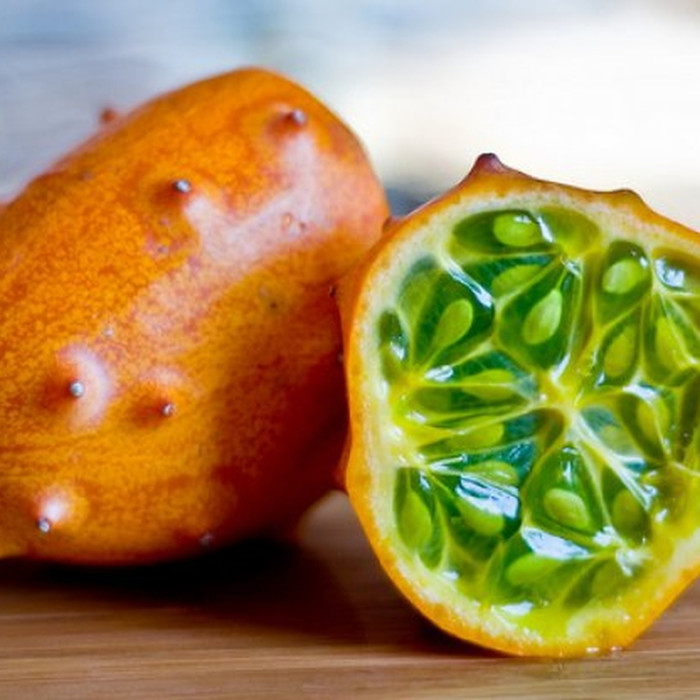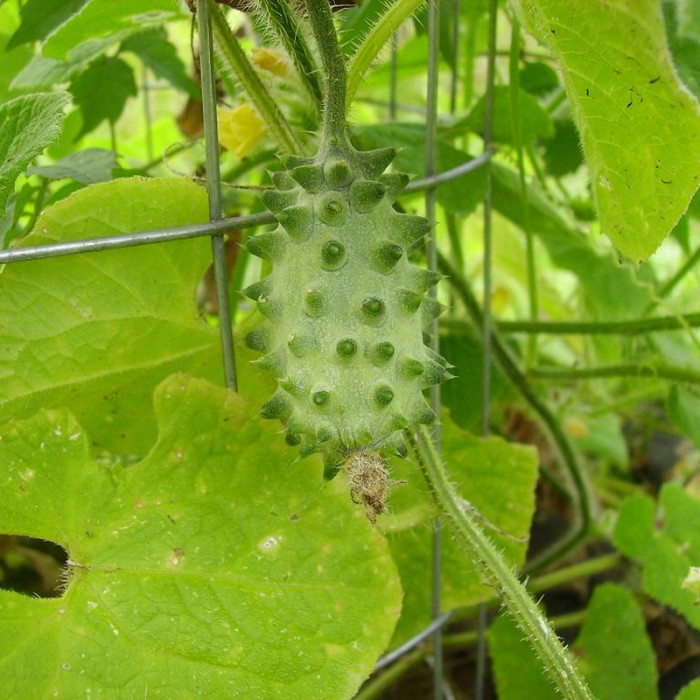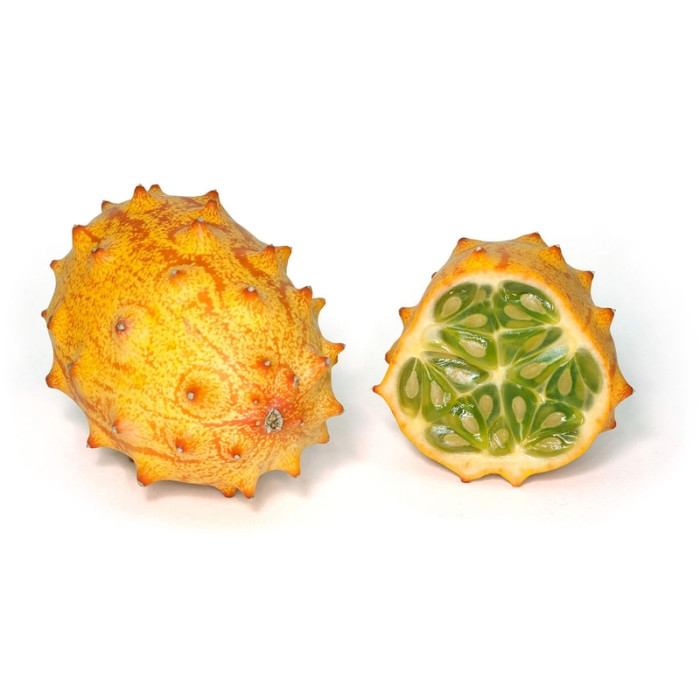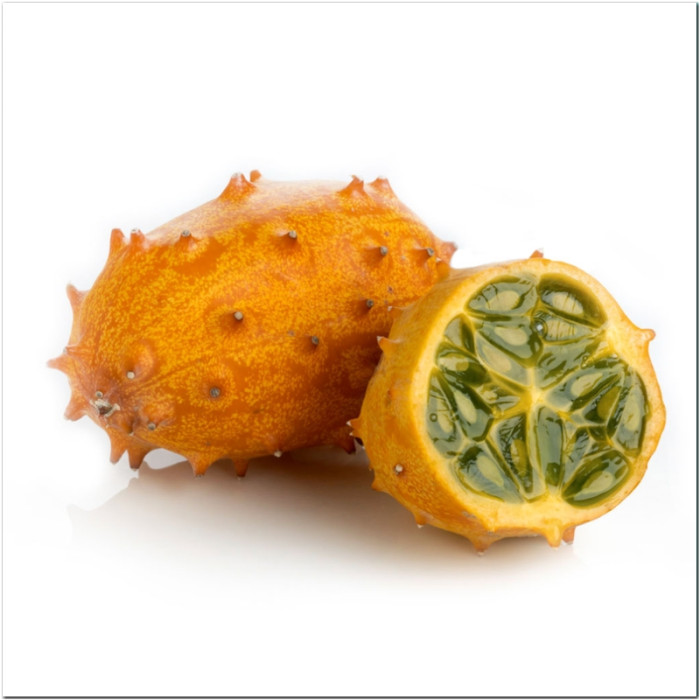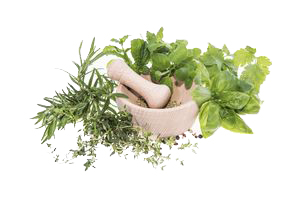African horned cucumber, horned melon, spiked melon, jelly melon, or kiwano / Cucumis metulifer
Herbaceous liana of the Cucurbitaceae family, species of the Cucumber genus (Cucumis). The length of the plant reaches three meters. Comes from Africa. It is grown for its edible fruit, which looks like a small oval melon with thorns.
Kiwano fruit is yellow, orange or red in color with an inedible tough leathery rind covered with soft spines. It has green jelly-like flesh with pale green seeds. Fruit length - up to 15 cm.
Kiwano is less demanding on soil fertility than cucumber, but prefers good drainage and nutrient availability. This is a short-day plant, light-loving and heat-loving, it does not tolerate frost, and temperatures below 12 ° C, growing in shaded and acidic areas retard its growth and development. The optimum temperature for Kiwano is 25°C.
Unlike other cucurbits, it is resistant to many harmful diseases and is almost not damaged by pests. Propagated by seeds, cuttings and seedlings. Kiwano is an annual dioecious plant with a growing season from germination to fruit ripeness of 75-77 days. Creeping stems 3 m long. Leaves slightly dissected, green. Fruits are oval with a tuberculate surface, light green when unripe and yellow when ripe, weighing an average of 150 grams, stored after removal up to 6 months.
The yield with a planting pattern of 40x35 cm is 3.6 kg per 1 m2.
Growing Kiwano
Best of all through seedlings. Seeds for seedlings should be sown a month before planting in a permanent place (in late April - early May). The day before sowing, they are soaked in a solution of Epin extra or sodium humate. The swollen seeds are immediately placed in a pot with a diameter of 8-10 cm, filled with a light nutrient soil mixture, to a depth of 3 cm.
Seedlings can be planted in a greenhouse or under a wall in the middle or at the end of May, in open ground - only after the frost period has passed. In a greenhouse, kivano is planted in 2 rows with a distance between rows of 40 cm, and between plants in a row of 35-40 cm. In open ground, it should be placed in places protected from the cold wind, along a mesh fence, buildings or arbors (the optimal distance between plants while 50-80 cm).
Seedlings must be tied with twine to a vertical trellis and periodically twisted around it as the main stem grows clockwise. Kiwano grows quickly and looks very impressive during flowering and fruiting. When caring for plants, it is important to loosen the soil around them, weed regularly, and in hot and dry summers, water 2-3 times a week.
Kiwano plants are very responsive to top dressing, which should be carried out regularly, every 10-12 days, with mullein or grass infusion, diluted with water in a ratio of 1:5 (or chicken droppings - 1:15). It is better to alternate organic top dressing with mineral ones, using complex mineral fertilizers (Kemira wagon - 20 grams per 5 liters of water). Useful foliar top dressing on the leaves with any complex fertilizer with trace elements at a concentration of an aqueous solution of not more than 0.25%.
With a strong thickening, the side shoots are pinched to the ovary (those with an empty flower - male flowers - can be cut out completely). Young ovaries at the age of 4-7 days are removed in a day or two. The sooner they are harvested, the faster new fruits grow.
Several fruits are left on the seeds until fully ripe. At the end of the growing season, all the fruits are harvested, and the plants are laid in compost.
If you want to grow a kiwano on a loggia, balcony or indoors, then it is best to use a container of 5-25 liters for this, and also provide for manual pollination of flowers, transferring pollen from male plants to the stigma of female plants with a brush. Female flowers open early in the morning and wither by evening, so pollination is best done from morning to 12 noon, while the pollen is viable. Although the nodule is photophilous, in spring and summer, when the sun is bright on the window, its leaves burn out - on such days they should be shaded with gauze or a mosquito net.
Kiwano fruit tastes like cucumber and banana. It can be used both in sweet and salty form. Used in salty salads with salt and pepper in lemon juice. Also used in fruit and milkshakes and fruit drinks. It contains few calories, so it is often used in dietary nutrition and weight loss diets.
The taste is quite specific, with sourness, I liked it, but on the lover.
No questions about this product, be the first and ask your question.


